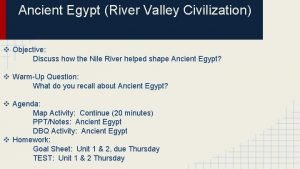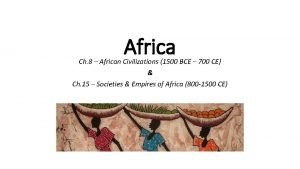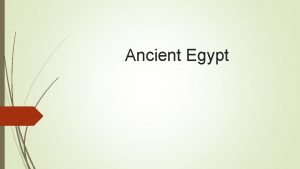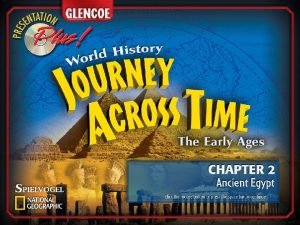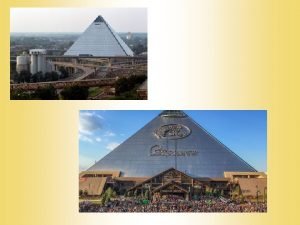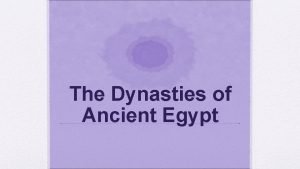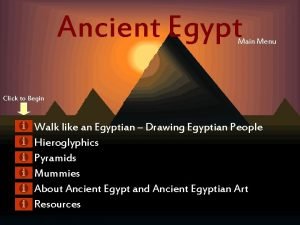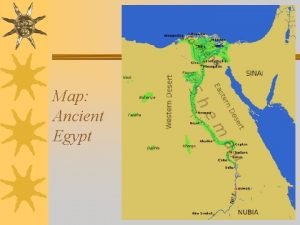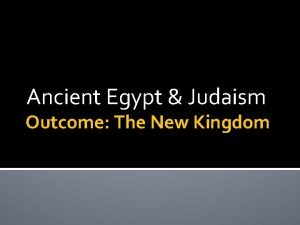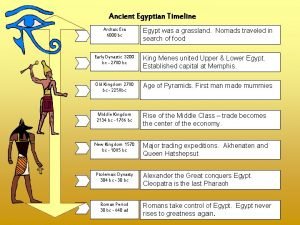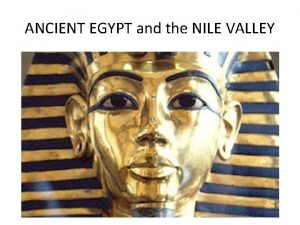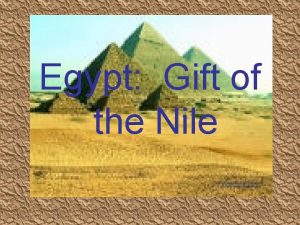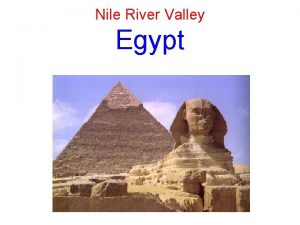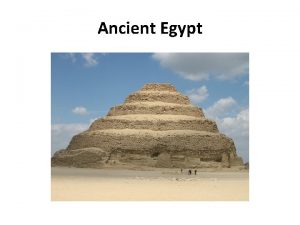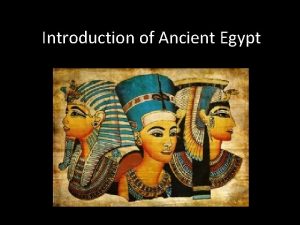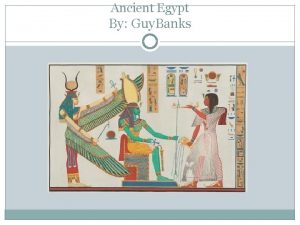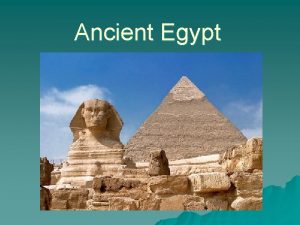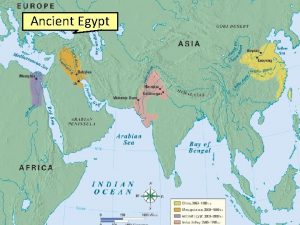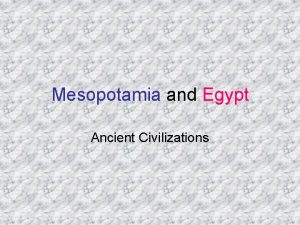The Nile Valley of Ancient Egypt Pg 38



















- Slides: 19

The Nile Valley of Ancient Egypt Pg. 38 -46

Vocabulary • Cataract-Steep/wild rapids created by cliffs and boulders. • Delta-End of a river that branches out over an area of fertile soil. • Papyrus-Reed like plant that grows along the Nile used to make baskets, sandals, rafts, and paper. • Hieroglyphics-Egyptian writing system using picture and sound symbols. • Dynasty-A line of rulers from one family

Settling the Nile • Between 6000 BC/BCE and 5000 BC/BCE people began to settle the Nile River Valley for its fertile land. They became known as Egyptians. (What time period is this) A Mighty River • Area lacks rainfall, so the Nile River is relied on. • It was used for drinking, bathing, irrigation, cooking. Provided fish and supported plant and animal life. • Egyptians view the Nile as a precious gift.

Settling the Nile • Today: World’s longest river, over 4, 000 miles long. Flows north from high lands of Central Africa to the Mediterranean Sea. • Much of the Nile is filled with cataracts, narrow cliffs and boulders that form wild rapids. • Large ships only use the last 650 miles of the Nile.

Nile River Cataract

Settling the Nile A Sheltered Land • The Nile creates one of the largest deltas in the world. • A delta is an area of fertile soil at the mouth of a river. • On both sides of the Nile there is desert. • To the west is the largest desert in the world, the Sahara.

Settling the Nile • To the east is the Eastern Desert. • Deserts served a purpose: Kept enemies out of Egypt. • Other geographic features of protection: Cataracts of the Nile, delta marshes, Mediterranean Sea, and Red Sea. • Nile was/is used for trade and transportation.

Nile River Delta Note the branching out! Why is it GREEN in the delta?

The River People Regular Flooding • Egyptians had to cope with river flooding. • Floods caused by heavy rains in Central Africa and melting snows in the highlands. • Floods left dark, fertile mud which made the land fertile. How did Egyptians use the Nile? • Took advantage of floods.

The River People • Planted wheat and barley. • Used the water for irrigation. • Developed geometry to survey land that flood waters washed out. • Used papyrus, a plant along the Nile, to make baskets, and rafts. It was also used as paper. What are Hieroglyphics? • A way of communication for the Ancient Egyptians. • A creation of picture symbols that stood for sounds and words became known as hieroglyphics.

Papyrus

Paper made of Papyrus

The River People • Few people could read and write in Ancient Egypt. • Those that could were often scribes, or record keepers for the rulers, priests, and traders……just like Mesopotamia.

United Egypt • Skillful farming led to surplus, or extra, which allowed people to work in other areas. • More good became available, resulting in more trade between Egyptians. Rise of Government • Because of a growth in population and increased disputes of land ownership government had to be formed.

United Egypt • Gradually government grew to overlook the people and decisions to be made.

Early Egyptian Life Egypt’s Social Classes • Three classes: Upper, middle, and low. • Upper: Priests, government officials, and the wealthy. These people had elegant homes and wore jewelry. • Middle: People who ran businesses, traders, shopkeepers, and scribes. • Low: Farmers, Unskilled workers, those who unloaded boats, stacked mud bricks, or did physical labor.


Early Egyptian Life Family Life • Father headed the family. • Egyptian woman had many rights, such as own property, buy/sell goods, and obtain divorces. • Few went to school. • Mothers taught daughters to sew, cook, and run the house. • Fathers taught sons to farm and skilled trades. • Children played with board games, dolls, and stuffed leather balls.

Compare/Contrast • How was/is Ancient Mesopotamia and Ancient Egypt similar? Give some examples. • How was/is Ancient Mesopotamia and Ancient Egypt different? Give some examples.
 How did the nile shape ancient egypt
How did the nile shape ancient egypt How did the nile shape ancient egypt dbq answer key
How did the nile shape ancient egypt dbq answer key What lasting legacies did the aksum kingdom leave
What lasting legacies did the aksum kingdom leave Egypt is the gift of the nile
Egypt is the gift of the nile Janapriya nile valley madinaguda
Janapriya nile valley madinaguda Nile river valley advanced cities
Nile river valley advanced cities Why was napata location advantageous
Why was napata location advantageous Upper egypt and lower egypt
Upper egypt and lower egypt Organism
Organism Ancient egypt slogans
Ancient egypt slogans Relative location of cairo egypt
Relative location of cairo egypt Egypt vocabulary
Egypt vocabulary Workbook page 19
Workbook page 19 Frontalism ancient egypt
Frontalism ancient egypt Ancient egypt map
Ancient egypt map Ancient egypt and judaism outcome the new kingdom
Ancient egypt and judaism outcome the new kingdom Ancient greece egypt
Ancient greece egypt Egyptian religion timeline
Egyptian religion timeline Ancient command economy
Ancient command economy Ancient egypt non chronological report
Ancient egypt non chronological report

